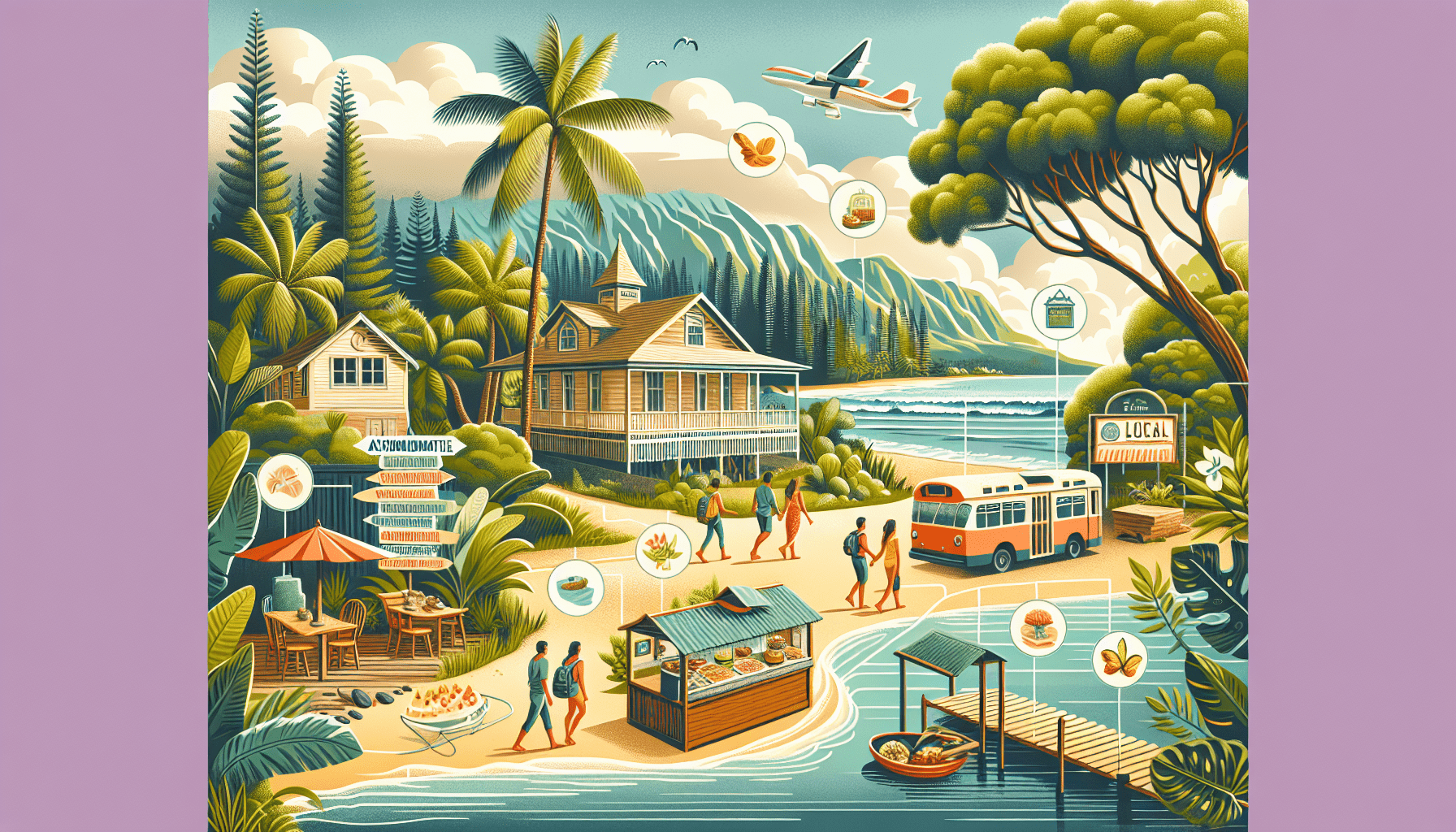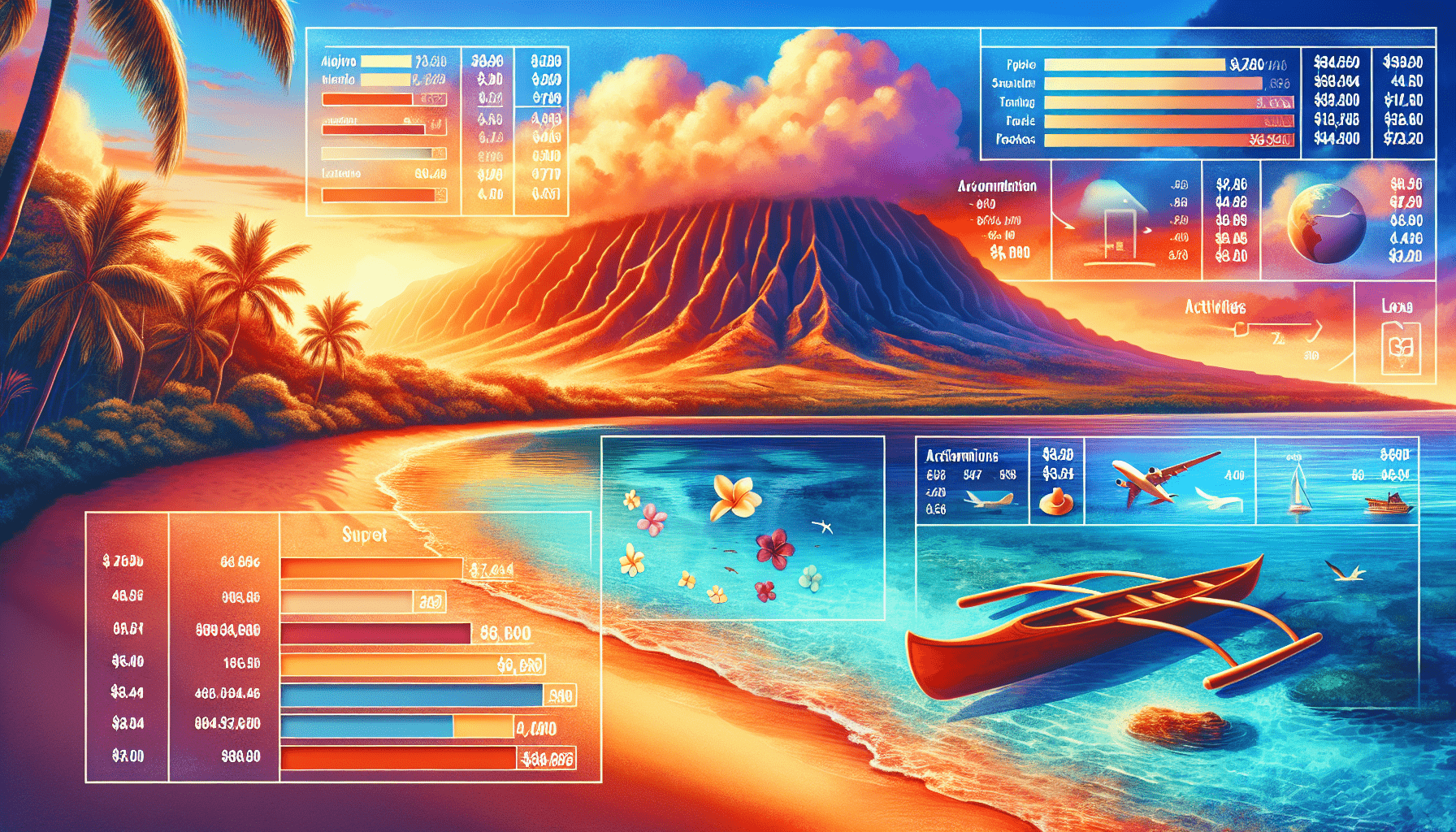Yamadura Mini Refillable Perfume Portable Atomizer Bottle Refillable Perfume Spray, Refill Pump Case for Traveling and Outgoing (5ml, 4 Pack) 4
$8.99 (as of April 16, 2025 04:30 GMT +00:00 - More info)Planning a week-long vacation in Hawaii and curious about how much it might cost? Look no further! In this article, we’ll give you all the details and information you need to know about the average expenses for a week-long getaway in paradise. From accommodation and food to activities and transportation, we’ll cover it all so you can plan your dream vacation without breaking the bank. So, get ready to soak up the sun and explore the breathtaking beauty of Hawaii, all while keeping your budget in check. Let’s dive in!
Accommodation
Choosing the Right Accommodation
When planning a vacation to Hawaii, one of the first things you need to consider is your accommodation. With so many options available, it can be overwhelming to choose the right one. Do you prefer a luxury hotel, a cozy beachfront cottage, or a budget-friendly hostel? Think about your preferences, budget, and the location you want to stay in. The most popular areas for tourists in Hawaii include Waikiki in Oahu, Lahaina in Maui, and Kailua-Kona in the Big Island. Research different accommodations and read reviews to find the best fit for your vacation.
Average Cost of Accommodation
The cost of accommodation in Hawaii can vary widely based on factors such as location, type of accommodation, and the time of year you plan to visit. On average, you can expect to pay between $150 to $400 per night for a hotel room. Luxury resorts can cost upwards of $500 per night, while budget-friendly options like hostels or vacation rentals can be as low as $50 to $100 per night. Keep in mind that prices tend to be higher during peak tourist seasons and holidays.
Factors Affecting Accommodation Expenses
Several factors can affect the cost of accommodation in Hawaii. The time of year you visit plays a significant role, as prices tend to increase during peak tourist seasons such as summer and around major holidays. The location of your accommodation also influences the cost, with beachfront properties and properties in popular tourist areas being more expensive. Additionally, the type of accommodation you choose, such as a hotel, vacation rental, or hostel, will impact the overall expenses. It’s important to consider these factors when budgeting for your Hawaii vacation.
Transportation
Flights to Hawaii
Getting to Hawaii is an essential part of your vacation planning. The main airports in Hawaii are Honolulu International Airport (HNL) on Oahu, Kahului Airport (OGG) on Maui, and Kona International Airport (KOA) on the Big Island. Numerous airlines offer flights to Hawaii from various cities in the United States and internationally. The cost of flights can vary depending on factors such as the time of year, the airline, and how far in advance you book. It’s advisable to book your flights well in advance to secure the best deals.
Inter-Island Travel
If you plan on exploring multiple islands during your Hawaii vacation, you’ll need to consider inter-island travel. The most common way to travel between islands is by taking a short domestic flight. Airlines such as Hawaiian Airlines, Southwest Airlines, and Mokulele Airlines offer affordable inter-island flights. You can also opt for ferry services, although these are limited and less frequent. Be sure to factor in the cost of inter-island travel when planning your budget.
Rental Cars
Renting a car in Hawaii gives you the freedom to explore the islands at your own pace. When it comes to rental cars, prices can vary depending on the type of vehicle, the rental duration, and the demand during your visit. On average, you can expect to pay around $50 to $100 per day for a standard rental car. It’s advisable to book your rental car in advance to secure the best rates and ensure availability, especially during peak tourist seasons.
Public Transportation
If you’re looking for a more budget-friendly option for getting around in Hawaii, public transportation is a viable choice. The bus system, known as TheBus, operates on most major islands and offers affordable fares. The cost of a one-way bus fare is generally around $2 for adults. However, keep in mind that public transportation may have limited routes and schedules, so plan your activities accordingly. It’s also worth noting that public transportation may not be as convenient for exploring remote or less touristy areas.
Meals
Dining Options
Hawaii is known for its diverse culinary scene, offering a wide variety of dining options to suit every taste and budget. From upscale restaurants serving fresh seafood to food trucks selling delicious local delicacies, you’ll find something for everyone. Popular dining areas include Waikiki in Oahu, Lahaina in Maui, and Kapa’a in Kauai. Consider trying local Hawaiian dishes such as poke, plate lunches, and shave ice for an authentic culinary experience. Don’t forget to indulge in a Hawaiian luau for a cultural and culinary adventure.
Average Cost of Meals
The cost of meals in Hawaii can vary depending on where you choose to dine. Fine dining restaurants and resorts tend to be more expensive, with prices ranging from $30 to $100 per person for a full meal. Mid-range restaurants and casual eateries typically charge around $15 to $30 for a meal. For budget-friendly options, food trucks and local markets offer delicious meals for as low as $10. Keep in mind that prices can be higher in popular tourist areas, so exploring local spots can help you save money.
Budget-Friendly Meal Choices
If you’re looking to save money on meals during your Hawaii vacation, there are several budget-friendly options to consider. One popular choice is to visit local farmers markets, where you can find fresh produce, snacks, and prepared meals at affordable prices. Take advantage of happy hour specials at restaurants and bars, where you can enjoy discounted drinks and appetizers. Lastly, consider packing your own snacks and picnicking at scenic spots to enjoy the beauty of Hawaii while saving money on meals.

Activities
Popular Tourist Activities in Hawaii
Hawaii is famous for its stunning natural landscapes, vibrant culture, and countless outdoor activities. Some popular tourist activities in Hawaii include visiting the Pearl Harbor National Memorial in Oahu, exploring Haleakala National Park in Maui, snorkeling in Hanauma Bay on Oahu, and hiking the Kalalau Trail in Kauai. You can also enjoy water sports such as surfing, kayaking, and paddleboarding, or indulge in scenic drives and sunset cruises. With so many options available, there’s something for everyone to enjoy in Hawaii.
Average Cost of Activities
The cost of activities in Hawaii can vary depending on the type of activity and the location. For example, admission fees to popular attractions such as national parks or museums can range from $10 to $30 per person. Guided tours, such as helicopter tours or snorkeling excursions, can cost anywhere from $100 to $300 per person. If you’re interested in water sports or renting equipment, prices typically range from $20 to $100, depending on the activity and duration. It’s advisable to research and compare prices in advance to find the best deals.
Free or Low-Cost Activities
Not all activities in Hawaii come with a hefty price tag. There are plenty of free or low-cost activities that allow you to enjoy the beauty of the islands without breaking the bank. Take advantage of the numerous public beaches and parks, where you can swim, sunbathe, and have a picnic for free. Hiking trails, such as the Diamond Head Summit Trail in Oahu or the Waimea Canyon Trail in Kauai, offer breathtaking views and are often free or require a minimal entrance fee. Additionally, attending local festivals and events can provide a unique cultural experience at little to no cost.
Shopping and Souvenirs
Popular Shopping Destinations
Shopping in Hawaii offers a diverse range of options, from high-end luxury boutiques to local markets selling unique souvenirs. Popular shopping destinations include the Ala Moana Center in Oahu, which is the largest open-air shopping center in the world, and the Luxury Row in Waikiki, known for its designer labels. On Maui, Front Street in Lahaina is a bustling area with shops offering everything from clothing to artwork. Don’t forget to explore local markets and specialty stores for traditional Hawaiian products and souvenirs.
Average Cost of Souvenirs
The cost of souvenirs in Hawaii can vary greatly depending on what you choose to purchase. Small trinkets such as keychains or magnets can range from a few dollars to around $10. Traditional Hawaiian gifts such as hula skirts, ukuleles, or handmade leis can cost anywhere from $20 to $50. For higher-end souvenirs such as artwork or jewelry, prices can go up to several hundred dollars or more. It’s advisable to set a budget for souvenirs and compare prices at different shops to find the best deals.
Tips for Souvenir Shopping
To make the most of your souvenir shopping in Hawaii, here are a few tips to keep in mind. First, consider shopping at local markets or roadside stands, where you can often find unique and affordable souvenirs. These small businesses often support local artisans and offer a more authentic shopping experience. Second, don’t be afraid to negotiate or ask for discounts, especially in open-air markets or when purchasing multiple items. Finally, consider the size and weight of your souvenirs, as you may need to pack them in your luggage for the return trip.
Travel Insurance
Importance of Travel Insurance
Travel insurance is an essential aspect of any vacation, including a trip to Hawaii. It provides financial protection and peace of mind in case of unexpected events such as trip cancellations, medical emergencies, or lost luggage. Hawaii is known for its unpredictable weather, and travel insurance can help cover any additional expenses that may arise due to flight delays or cancellations. It’s important to carefully review the coverage options and choose a travel insurance plan that best suits your needs.
Cost of Travel Insurance
The cost of travel insurance for a trip to Hawaii depends on several factors, including the duration of your stay, the level of coverage you choose, and your age. On average, you can expect to pay around 4-8% of the total trip cost for travel insurance. For example, if your week-long vacation to Hawaii costs $3,000, you can expect to pay between $120 to $240 for travel insurance. Comparing different insurance providers and their coverage options can help you find the best value for your money.
Choosing the Right Travel Insurance
When choosing travel insurance for your Hawaii vacation, it’s important to consider your specific needs and the level of coverage you require. Look for a policy that provides coverage for trip cancellation, trip interruption, emergency medical expenses, and lost baggage. Additionally, check the policy’s exclusions and limitations to ensure it aligns with your planned activities and any pre-existing medical conditions. It’s advisable to read reviews and consult with an insurance agent if you have any questions or need assistance in selecting the right travel insurance plan.
Miscellaneous Expenses
Tips and Gratuities
Tipping is a customary practice in Hawaii, and it’s important to factor tips and gratuities into your overall expenses. In restaurants, it is generally expected to tip around 15-20% of the total bill, depending on the level of service. Some restaurants may include a service charge automatically, so check the bill before adding an additional tip. For other services such as taxis, hotel staff, or tour guides, tipping around 10-20% of the service cost is customary. Be sure to carry some cash with you for tipping purposes during your vacation.
Entry Fees to Attractions
While there are many free or low-cost activities in Hawaii, some attractions may require an entry fee. National parks, such as Hawai’i Volcanoes National Park or Haleakala National Park, typically charge a fee ranging from $5 to $30 per person, depending on the park and the activities you plan to do. Some cultural sites or historical landmarks may also have entry fees. It’s advisable to check the websites or contact the attractions in advance to determine the entry fees and plan your budget accordingly.
Miscellaneous Expenses to Consider
Aside from the major expenses, there are various miscellaneous expenses to consider when budgeting for your Hawaii vacation. These can include airport parking fees, baggage fees for flights, spa treatments or massages, cab fare or rideshare services, and any additional activities or tours not included in your initial plans. It’s important to allocate some extra funds to account for these miscellaneous expenses to avoid any unexpected financial strain during your vacation.
Currency Exchange
Understanding Currency Exchange
When traveling to Hawaii from a foreign country, it’s important to understand the currency exchange process. The official currency in Hawaii and the rest of the United States is the US Dollar (USD). Most businesses in Hawaii accept credit and debit cards, which can be used for most transactions. However, it’s advisable to carry some cash for small purchases, tips, or in case of emergencies. If you need to exchange your foreign currency for US Dollars, you can do so at banks, currency exchange offices, or airports.
Where to Exchange Currency
In Hawaii, you can exchange currency at banks, credit unions, or currency exchange offices. Many major hotels and resorts also offer currency exchange services, although the rates may not always be the most favorable. It’s advisable to compare the exchange rates and fees at different locations to ensure you get the best value for your money. Additionally, check if your bank offers partnerships with other financial institutions in Hawaii, as this can provide more favorable exchange rates and lower fees for account holders.
Avoiding Extra Fees
When exchanging currency or using credit cards in Hawaii, it’s important to be aware of any potential extra fees. Some currency exchange offices or banks may charge transaction fees or have less favorable exchange rates. When using credit or debit cards, check with your bank to see if they charge foreign transaction fees. To avoid extra fees, consider withdrawing cash from ATMs within your network or using credit cards that offer no foreign transaction fees. It’s advisable to inform your bank of your travel plans to avoid any issues with international transactions.
Budgeting Tips
Creating a Realistic Budget
Creating a realistic budget is crucial to enjoying your Hawaii vacation without overspending. Start by determining your overall trip budget, including accommodation, transportation, meals, activities, shopping, and miscellaneous expenses. Research and estimate the costs for each category based on your preferences and the specific factors discussed earlier. Be sure to allocate some extra funds for unexpected expenses or emergencies. Remember to track your expenses during your trip to ensure you stay within your budget.
Ways to Save Money
While Hawaii can be an expensive destination, there are several ways to save money and stretch your budget. Booking flights and accommodations in advance can help secure better rates. Consider cooking some of your meals or picnicking instead of dining out for every meal. Take advantage of free or low-cost activities such as hiking, visiting public beaches, or attending local festivals. Shopping at local markets and bargaining for discounts can also help you save on souvenirs. Look out for happy hour specials or affordable food trucks for budget-friendly dining options.
Prioritizing Expenses
As you plan your Hawaii vacation budget, it’s important to prioritize your expenses based on what is most important to you. Consider what experiences or activities you value the most and allocate a larger portion of your budget towards those. For example, if you’re a food lover, you may want to spend more on dining options and culinary experiences. If adventure and outdoor activities are your focus, allocate a larger portion of your budget to activities such as snorkeling, hiking, or zip-lining. By prioritizing your expenses, you can ensure a more fulfilling and enjoyable vacation within your budget.
Final Thoughts
Overall Cost of a Week-Long Vacation
The overall cost of a week-long vacation in Hawaii can vary greatly depending on your preferences, choices, and the factors discussed throughout this article. On average, you can expect to spend between $3,000 to $5,000 per person for a week-long vacation in Hawaii. This estimate includes accommodation, transportation, meals, activities, shopping, and miscellaneous expenses. Keep in mind that this is a general estimate, and your actual expenses may be higher or lower depending on your choices and the time of year you visit.
Factors That Can Impact Expenses
Several factors can impact your expenses during a vacation in Hawaii. The time of year you visit is a significant factor, as prices tend to be higher during peak tourist seasons and holidays. The location you choose to stay in, the type of accommodation you choose, and the activities you plan to participate in also impact expenses. Dining at upscale restaurants and shopping for high-end souvenirs will be more expensive compared to budget-friendly options. Inter-island travel and rental car costs should be considered as well. Understanding these factors can help you plan and budget more effectively.
Enjoying Hawaii Within Your Budget
While Hawaii may have a reputation for being an expensive destination, it is possible to enjoy a memorable vacation within your budget. By carefully researching and planning your trip, you can find affordable accommodation, dining options, and activities. Taking advantage of free or low-cost attractions and shopping at local markets can also help you save money. Prioritizing your expenses based on your preferences and interests ensures a fulfilling and enjoyable vacation without overspending. With proper budgeting and a little creativity, you can create lasting memories in the beautiful islands of Hawaii without breaking the bank.











